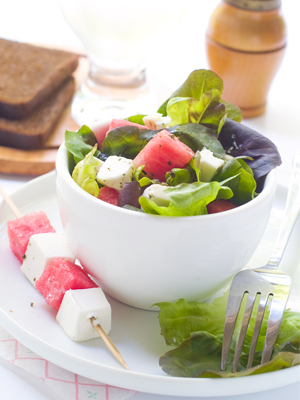Finding fresh fruits and vegetables when they’re in season can be a challenge. Trying to turn them into meals can be a bigger challenge if you’re not feeling the culinary creativity. Don’t let prime fruits and veggies go to waste when you’re drawing a bland blank. Read on for ways to add August in-season fruit and veg into meals.
For camping “ The amount of meal prep and cooking required for a healthy camp dinner is usually cringe-worthy.
But you don’t have to resort to hot dogs, s’mores and individually-packaged cereal (without milk) for an entire weekend. Watermelon is perfect for a day at the beach. A cut watermelon will provide for a lot of people, and bonus: you’re less likely to get dehydrated if you’re snacking on it all day.
Stuffed bell peppers are a delicious break from pre-packaged meat. Hollow out peppers and stuff them with the filling of your choice, like mushrooms and precooked shrimp, or tomatoes and goat cheese. Wrap them in tinfoil and let them snuggle up to the campfire coals to cook.
If you want to get really healthy, substitute goat cheese for ricotta as it’s lower in fat, and add spinach to your tomato mix to add a hit of iron. The spinach/tomato mix is especially beneficial as the vitamin C in tomatoes helps the body absorb more iron than it would from spinach alone.
For lunches “ Fruit is great as a snack or lunch side at work, but apples and bananas can get dull day after day.
Try throwing an apricot or blueberries in your lunch. Apricots are rich in vitamin A, which improves vision and helps prevent skin diseases (including acne!). Blueberries have lots of fibre and vitamin C, and have been consistently rated as one of the fruits highest in antioxidants.
If you want to get really healthy, combine the two by slicing up the apricot to make a fruit salad.
For dinner time – Pureeing vegetables is a great way to bump up nutrition in creamy comfort food without sacrificing flavour or texture.
Pureed cauliflower is perfect for mac n’ cheese because of its colour (it’ll blend with white or regular cheddar) and sweet flavour. Cauliflower is full of vitamin C, which produces collagen and helps heal wounds, and the puree makes mac n’ cheese creamy in a way you just can’t get with cheese alone. Try adding grated nutmeg to the cauliflower to give it a nutty spiced flavour; it’s the same spice used in bé©chamel (white cream) sauce.
My favourite way to make risotto is with pureed peas. Green peas are only freshly available from June to July, but snow peas will work just as well. The puree makes your risotto even creamier and substitutes a lot of the butter and cheese you’d usually need to get the same result. Try pureeing the peas with fresh basil, mint or dill for different flavours.
If you want to get really healthy, substitute the peas for pureed Swiss chard or spinach, which offer more minerals like iron, magnesium and potassium than snow peas.
All around all stars “ Leeks and tomatoes are versatile in flavour and texture and can be used in virtually any meal.
Used together or separately, they are fantastic in soups, quiches, pies, pasta or rice, salads or as stand-alone side dishes. They also add flavour to sauces or dips like guacamole or hummus.
Tomatoes have a unique flavour that just can’t be compared with other produce. They can be cut or pureed to go with just about anything, but they can work well as the main ingredient, too. Try stuffing tomatoes, or a simple tomato basil salad with balsamic vinegar. Tomatoes are rich in vitamins A and C.
Anywhere you would use onion or garlic, try leeks instead. Their flavour is milder than garlic and sweeter than onion but still adds a bit of a kick. Leeks also offer vitamin A as well as vitamin K, which helps improve bone density and prevent the hardening of arteries.











